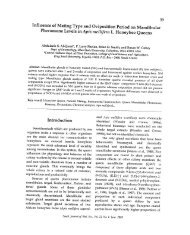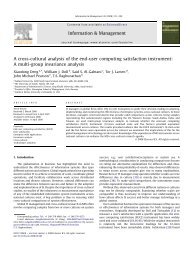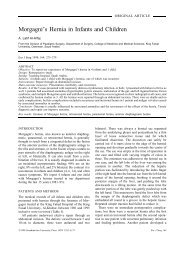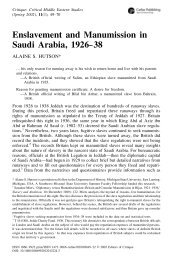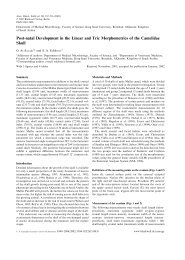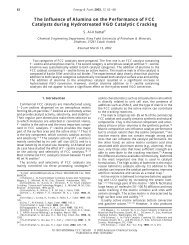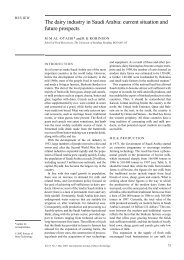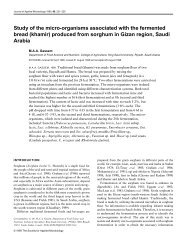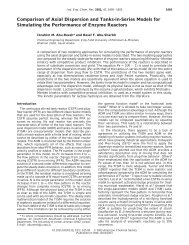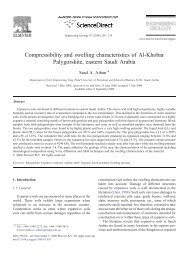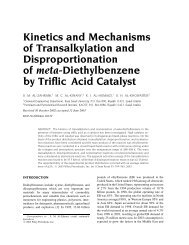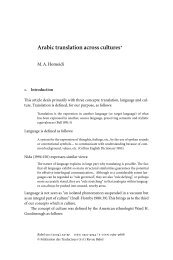Role of racemization in optically active drugs development
Role of racemization in optically active drugs development
Role of racemization in optically active drugs development
You also want an ePaper? Increase the reach of your titles
YUMPU automatically turns print PDFs into web optimized ePapers that Google loves.
456 ALI ET AL.<br />
Time (m<strong>in</strong>)<br />
TABLE 2. Enantiomeric ratio <strong>of</strong> Ibupr<strong>of</strong>en as<br />
CoA-thioesters and free after <strong>in</strong>cubation <strong>in</strong> liver<br />
mitochondrial fraction <strong>of</strong> rat 31<br />
(R)-Ibupr<strong>of</strong>en-CoA (S)-Ibupr<strong>of</strong>en-CoA<br />
S/R CoA S/R Free R/S CoA R/S Free<br />
10 0.76 0.61 0.77 0.67<br />
20 0.62 0.69 0.58 0.78<br />
30 0.70 0.67 0.56 0.77<br />
60 0.56 0.67 0.63 0.77<br />
with the amount <strong>of</strong> (S)-ibupr<strong>of</strong>en formed equal to lost<br />
amount <strong>of</strong> (R)-ibupr<strong>of</strong>en. In the same way, (S)-ibupr<strong>of</strong>en-<br />
CoA racemized to (R)-ibupr<strong>of</strong>en-CoA, and their rate <strong>of</strong> hydrolysis<br />
and <strong>racemization</strong> was reported same as for<br />
(R)- and (S)-ibupr<strong>of</strong>en-CoA. The mitochondrial fraction<br />
mediated the <strong>racemization</strong> and hydrolysis <strong>of</strong> (R)- and (S)ibupr<strong>of</strong>en-CoA<br />
<strong>in</strong> the same pattern as rat liver homogenate.<br />
The enantiomer ratio <strong>of</strong> ibupr<strong>of</strong>en-CoA with rat liver<br />
mitochondrial fraction was not altered even after 1 h period<br />
<strong>of</strong> experiment. Table 2 31 shows the ratios <strong>of</strong> S/R CoA<br />
as free S/R, which <strong>in</strong>dicates different pattern <strong>of</strong> <strong>racemization</strong><br />
<strong>in</strong> rat liver mitochondrial fraction. A rapid <strong>racemization</strong><br />
and hydrolysis <strong>of</strong> (R)-ibupr<strong>of</strong>en-CoA to (S)-ibupr<strong>of</strong>en-CoA<br />
was reported <strong>in</strong> microsomal fraction. (S)-Ibupr<strong>of</strong>en-CoA<br />
racemized and hydrolyzed to (R)-ibupr<strong>of</strong>en-CoA with<br />
microsomal fraction. But it was observed that the rate<br />
<strong>of</strong> hydrolysis <strong>of</strong> (S)-ibupr<strong>of</strong>en was slower than that <strong>of</strong><br />
(R)-ibupr<strong>of</strong>en-CoA. In rat liver microsomal fraction, a<br />
difference <strong>in</strong> enantiomer ratios was reported and given<br />
<strong>in</strong> Table 3. 31 Knadler and Hall 32 reported the <strong>racemization</strong><br />
and hydrolysis <strong>of</strong> CoA thioesters <strong>of</strong> (R)-ibupr<strong>of</strong>en<br />
and (R)-fenopr<strong>of</strong>en with rat liver microsomal and mitochondrial<br />
fraction, which supported the f<strong>in</strong>d<strong>in</strong>gs <strong>of</strong><br />
Nakamura et al. 33 <strong>in</strong> 1981. Skalova et al. 34 reported chiral<br />
<strong>in</strong>version <strong>of</strong> R-(þ)-flobufen and (2S;4S)-dihydr<strong>of</strong>lobufen<br />
(DHF) <strong>in</strong> human hepatocytes. The authors also<br />
reported the unidirectional chiral <strong>in</strong>version <strong>of</strong> the enantiomers<br />
<strong>of</strong> dihydr<strong>of</strong>lobufen (DHF) as (2S;4S)-DHF to<br />
(2R;4S)-DHF and from (2R;4R)-DHF to (2S;4R)-DHF <strong>in</strong><br />
hepatocyte cultures. The chiral <strong>in</strong>version has also been<br />
discussed for 2-aryloxypropionates 35,36 and for D-leuc<strong>in</strong>e<br />
37 <strong>in</strong> human hepatocytes. Wsol et al. 38 studied <strong>in</strong><br />
vitro stereoselective biotransformation <strong>of</strong> flobufen enantiomers<br />
<strong>in</strong> hepatocytes <strong>of</strong> male rat. The authors also<br />
reported that bidirectional chiral <strong>in</strong>version occurred <strong>in</strong><br />
flobufen enantiomers with hepatocytes.<br />
Yang et al. 39–47 carried out a remarkable work on the<br />
<strong>racemization</strong> <strong>of</strong> various <strong>optically</strong> <strong>active</strong> <strong>drugs</strong>. The<br />
authors 45 reported that the conjugated benzylic C-H at chiral<br />
center was responsible for the <strong>racemization</strong> reaction <strong>in</strong><br />
oxazepam. Yang and Lu 44 studied the temperature dependent<br />
<strong>racemization</strong> <strong>of</strong> 3-methoxy-N-desmethyldiazepam <strong>in</strong><br />
acetonitrile and methanol hav<strong>in</strong>g 0.5 M H 2SO 4. Yang and<br />
Bao 42 reported base catalyzed <strong>racemization</strong> <strong>of</strong> 3-O-acyloxazepam.<br />
The authors studied the k<strong>in</strong>etics <strong>of</strong> <strong>racemization</strong> <strong>in</strong><br />
alkal<strong>in</strong>e solutions with and without buffered conditions.<br />
The authors also <strong>in</strong>dicated that <strong>in</strong> aqueous solutions the<br />
Chirality DOI 10.1002/chir<br />
<strong>racemization</strong> process took place with chang<strong>in</strong>g rates at pH<br />
7.5–14. The authors also suggested that this <strong>racemization</strong><br />
reaction occurred due to keto-enol tautomerism between<br />
C 2 carbon <strong>of</strong> CO group and C 3 carbon catalyzed by a<br />
base. Similarly, Yang 43 reported acid catalyzed <strong>racemization</strong><br />
<strong>of</strong> 3-O-methyloxazepam <strong>in</strong> ethanol and 3-O-ethyl oxazepam<br />
<strong>in</strong> methanol. The authors suggested that the above<br />
cited reaction occurred via C 3 carbocation <strong>in</strong>termediate.<br />
Yang et al. 41 reported that the enantiomers <strong>of</strong> oxazepam<br />
(OX) and temazepam (TMZ) showed the <strong>racemization</strong><br />
reactions 40 times faster than <strong>of</strong> hydrolysis <strong>of</strong> these racemates.<br />
The authors added that only hydrolysis results<br />
showed <strong>racemization</strong> reaction. Furthermore, Yang 40 studied<br />
the k<strong>in</strong>etics <strong>of</strong> spontaneous <strong>racemization</strong> and stereoselective<br />
conversion <strong>of</strong> temazepam (TMZ) enantiomers to<br />
3-O-methyltemazepam (MeTMZ) and 3-O-ethyltemazepam<br />
(EtTMZ). The authors also reported that N 4-protonated<br />
and unprotonated enantiomers <strong>of</strong> (S)-TMZ showed spontaneous<br />
<strong>racemization</strong>. A highly stereoselective nature was<br />
shown by three S-OH group <strong>of</strong> (S)-TMZ giv<strong>in</strong>g EtTMZ as<br />
a substituted product, which has greater proportion <strong>of</strong> (S)-<br />
EtTMZ. Sulla 48 reported that various aliphatic acid chlorides<br />
[RCH(R’)COCl], hav<strong>in</strong>g a chiral center adjacent to<br />
carboxylic group, showed a high degree <strong>of</strong> <strong>racemization</strong><br />
with strong acids.<br />
Ferorelli et al. 49 studied <strong>racemization</strong> <strong>of</strong> <strong>optically</strong> <strong>active</strong><br />
acid chlorides <strong>of</strong> cl<strong>of</strong>ibric acid with 3-tropanol. The authors<br />
reported that methanolic KOH hydrolysis <strong>of</strong> the methyl<br />
esters <strong>of</strong> 2-(4-chlorophenylthio)propanoic acid was produced<br />
as racemic mixture. The partial <strong>racemization</strong> <strong>of</strong> the<br />
above cited drug was reported with am<strong>in</strong>oalcohols as free<br />
base for the correspond<strong>in</strong>g esters and no <strong>racemization</strong><br />
was reported with am<strong>in</strong>oalcohols as hydrochloride salts. 50<br />
Mey et al. 51 reported 23–25 m<strong>in</strong> as half life <strong>of</strong> <strong>racemization</strong><br />
for (þ)- and ( )-diethylpropion (DEP) <strong>in</strong> human plasma.<br />
Tumambac et al. 52 reported half life <strong>of</strong> 2-benzoylcylohexanone<br />
<strong>in</strong> hexanes and ethanol as 552 and 23.8 m<strong>in</strong> respectively<br />
at 668C. Fernandez et al. 53 reported <strong>in</strong>creas<strong>in</strong>g <strong>racemization</strong><br />
<strong>of</strong> zopiclone (ZOP) enantiomers with <strong>in</strong>creas<strong>in</strong>g<br />
pH and temperature. Lamparter et al. 54 studied the <strong>racemization</strong><br />
<strong>of</strong> (þ)-chlorthalidone with variation <strong>of</strong> pH and<br />
reported a m<strong>in</strong>imum pH 3 for log K/pH curve. The<br />
authors also discussed that the rate <strong>of</strong> <strong>racemization</strong><br />
decreased with <strong>in</strong>creas<strong>in</strong>g liposome concentration. Teo<br />
et al. 5 reported the <strong>racemization</strong> <strong>of</strong> S-enantiomer <strong>of</strong> CC-<br />
4047 <strong>in</strong> phosphate buffer. The authors claimed S-enan-<br />
Time (m<strong>in</strong>)<br />
TABLE 3. Enantiomeric ratio <strong>of</strong> Ibupr<strong>of</strong>en as<br />
CoA-thioesters and free after <strong>in</strong>cubation <strong>in</strong> liver<br />
microsomal fraction <strong>of</strong> rat 31<br />
(R)-Ibupr<strong>of</strong>en-CoA (S)-Ibupr<strong>of</strong>en-CoA<br />
S/R CoA S/R Free R/S CoA R/S Free<br />
2 0.19 0.18 0.10 1.30<br />
5 0.22 0.19 0.19 0.57<br />
10 0.27 0.18 0.23 0.70<br />
20 0.47 0.19 0.21 0.98<br />
30 0.56 0.21 0.13 0.95<br />
60 0.76 0.25 0.10 0.82



